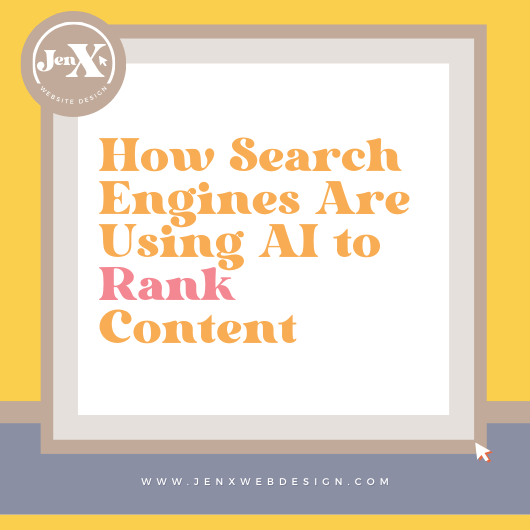How Google AI Search is Changing the Way We Blog for SEO
Just when we thought we had blogging for SEO dialed in, AI enters the picture and changes everything.
And if you don't adopt AI tools into your business operations because you think AI is [fill-in-the-blank-with-your-chosen-adjective], you’re going to fall behind.
It’s to be expected that major influencers in the digital and business landscape like Google incorporate AI into their strategies, products, and services to drive innovation and maintain a competitive edge. It would just be weird if they didn’t and, if I’m being honest, it’s foolish to gripe about it when they do.
With Google's primary objective, as outlined in its mission statement, being:
"To organize the world's information and make it universally accessible and useful,"
Google is using AI to drive how content is evaluated and ranked, creating a fundamental shift in the rules of engagement. The focus is no longer just on keywords or publishing lots of posts—it’s about creating high-quality, user-focused content that meets people where they are.
And frankly, I think this is a good thing.
For Squarespace users and bloggers looking to drive organic traffic, understanding these changes is crucial. Let me explain how Google AI Search has redefined SEO blogging and provide you with actionable tips to help you create content that ranks.
Google AI Search Prioritizes User Intent
Rather than matching keywords to a query, it tries to understand what the user actually wants. This is where its AI-driven tools, like BERT and MUM, come into play—they evaluate the meaning behind a search to deliver the most relevant, valuable content.
For example, if someone searches “how to start blogging on Squarespace,” Google AI isn’t just looking for keyword matches like “blogging” or “Squarespace.” It’s analyzing whether the content helps the user learn step-by-step how to start blogging, answers specific questions, or provides a unique perspective.
FAQ
Q1: Does this mean keywords are no longer important?
A1: Keywords still matter, but the focus has shifted to context. Use them naturally in well-written, informative content rather than forcing exact matches.
Q2: How does Google know what users really want?
A2: Google uses AI tools like RankBrain to analyze user behavior, such as how they interact with search results. If they click on your blog and stay engaged, it signals that your content is meeting their intent.
Why Quality Content is More Important Than Ever
Content quality is now the cornerstone of SEO blogging. Google AI evaluates how thoroughly your content answers a query, how engaging it is, and whether it provides unique insights. This means surface-level posts or keyword-stuffed blogs, while they’ve never been good, are a hard “NO” now.
As a Squarespace blogger, focus on creating posts that go deeper. Write how-to guides, case studies, and tutorials that genuinely help your audience solve their problems.
FAQ
Q1: What makes content “high quality” in Google’s eyes?
A1: High-quality content is informative, easy to read, and tailored to user needs. It answers questions comprehensively, provides actionable steps, and is visually appealing.
Q2: Should I write long blogs to rank better?
A2: Length doesn’t guarantee quality, but longer blogs (1,000+ words) often perform better because they allow you to explore topics in depth. Focus on substance, not just word count.
Q3: How do I keep readers engaged on my blog?
A3: Use clear headings, short paragraphs, and visuals like images or videos. Squarespace makes it easy to add these elements to your posts.
The Role of User Experience in Google AI Rankings
Google AI Search doesn’t just evaluate what you write—it evaluates how your audience interacts with your blog. Metrics like dwell time (how long users stay on your page) and bounce rate (how quickly they leave) help Google determine if your content is meeting the user’s needs.
A positive user experience comes down to how easy it is for visitors to navigate your blog, find what they’re looking for, and get their questions answered. If readers land on your post and can’t quickly locate helpful information, they’ll leave—and Google takes that as a sign your content isn’t useful.
To improve user experience:
Use clear headings that guide readers to the information they need.
Include internal links to related posts, so users can explore your site further.
Make sure your blog loads quickly and is mobile-friendly, as most searches now happen on mobile devices.
FAQ
Q1: How does page speed impact rankings?
A1: Slow-loading pages frustrate users, leading to higher bounce rates. Google AI sees this as a sign your content isn’t valuable. Use Squarespace’s built-in optimization tools to ensure fast load times.
Q2: Why is navigation so important for user experience?
A2: Clear navigation helps readers find the information they came for. If your blog is well-structured and intuitive, visitors are more likely to stay longer and explore other content.
Q3: Do internal links really help SEO?
A3: Yes! Internal links keep readers on your site longer and help Google understand the relationship between your pages, improving your overall SEO performance.
Writing for User Intent, Not Just Keywords
The biggest shift brought by Google AI Search is the emphasis on user intent. Instead of targeting single keywords, aim to answer the broader question behind the search. Long-tail, conversational keywords work especially well because they align with how people naturally search.
For instance, instead of trying to rank for “Squarespace blog,” target queries like “how to create an SEO-friendly blog on Squarespace.” This shows that your content is designed to meet a specific need.
FAQ
Q1: What’s the best way to identify user intent?
A1: Think about the why behind a search query. Use tools like Google’s “People Also Ask” or AnswerThePublic to find common questions related to your topic.
Q2: Can I still use traditional keywords?
A2: Yes, but use them as part of a natural flow. Write for humans first, and the keywords will fit seamlessly into your content.
Q3: How do I know if my blog is meeting user intent?
A3: Check your engagement metrics. If readers spend time on your blog, scroll through it, and interact with your content, you’re on the right track.
Final Thoughts
Google AI Search has changed how we blog for SEO. Instead of focusing solely on keywords or publishing frequently, the new priority is creating content that meets user intent, provides genuine value, and keeps readers engaged.
For Squarespace users, the good news is that your platform already offers tools to help you succeed in this new landscape—from beautiful, responsive templates to built-in SEO features. Combine these tools with high-quality, audience-focused content, and you’ll have a blog that performs well in today’s AI-driven search environment.
What’s been your biggest challenge with blogging in the Google AI era? Share your thoughts below—I’d love to hear them! 👇
If you liked this post, you’ll LOVE these:
This page contains affiliate links
Like this post?




















